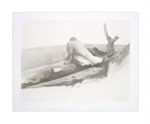
Study for April Wind
Study for April Wind
Andrew Wyeth was devoted to painting the people and landscapes of his hometown Chadds Ford in Pennsylvania, and his summer home in Cushing, Maine. As with many of his paintings, Wyeth did a number of studies prior to creating the final piece. ‘Study for April Wind’ is a case in point. It depicts a solitary man, head bent, sitting on the massive trunk of a fallen tree in a desolate field. ‘April Wind’ (1952), the final version, is housed in the Wadsworth Atheneum Museum of Art in Hartford, Connecticut.
The Subject
The male figure in ‘Study for April Wind’ was a friend of Andrew Wyeth, an African American man by the name of James Loper, also the subject of another famous portrait by Wyeth. Typical of Wyeth’s use of models, he is painted with his back to viewers. His coat collar partially disappears into his hunched shoulders, creating an impression of worry or sorrow in the man’s overall appearance. There is an aura of mystery about the figure, a sense that the man has a moving tale to tell. A strong wind blows his long coat outward - perhaps the gales of life that have buffeted this man continue to blow. His coat is well-worn, the hem is ragged, and a bit of light sneaks through a buttonhole. His gnarled hand rests firmly against the tree trunk, bracing his body not only against the wind, but also life itself. He appears lone and small in the vast expanse of the landscape stretching out into the unknown.
The finished piece, as well as the studies, focuses primarily on the ring adorning the man’s pinky finger. Masterfully achieved, light bounces off the ring’s reflective surface to produce one of the few bright spots in a painting otherwise dominated by muted shades – possibly, a ray of hope.